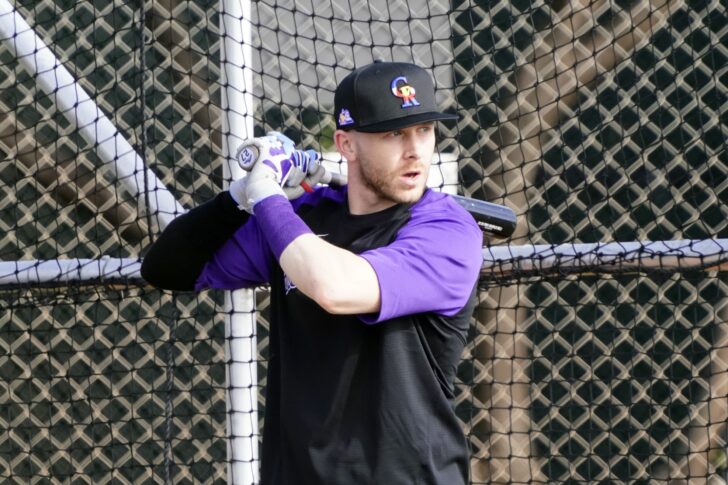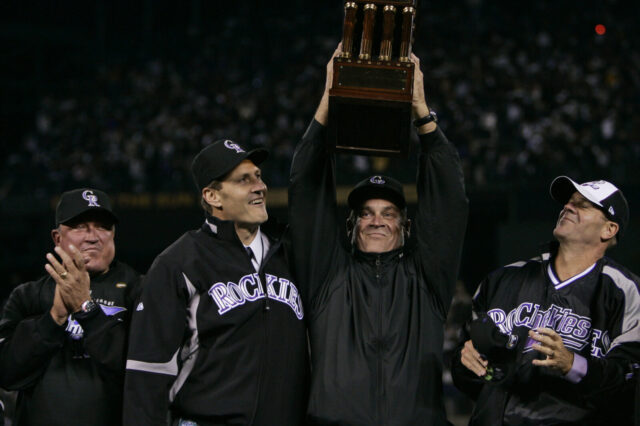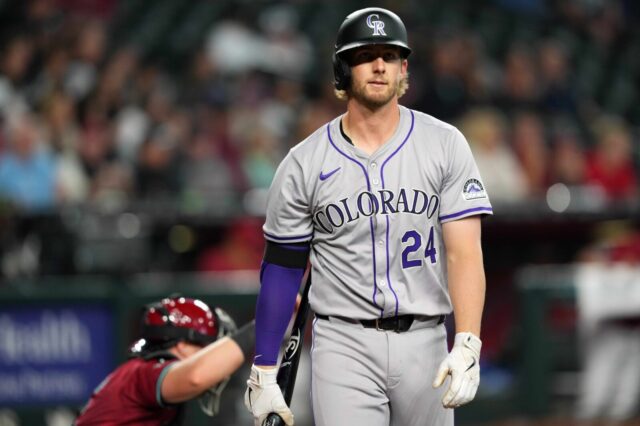A whole bunch of familiar faces, as well as some we haven’t seen much of before, have taken the field for the Colorado Rockies to officially kick off a spring training slate that should be somewhat bizarre; the Rockies are without star third baseman Nolan Arenado for the first time in nearly a decade, and baseball’s month-long slate of exhibition games was going to feel weird anyway considering it hasn’t really happened since 2019.
But the Rockies and their players are here to make the best of it. The players have already talked ad nauseam regarding entering the season with a chip on their collective shoulders, and it seems management believes the club has enough talent to compete.
Are they right about that? Probably not. But let’s dive into the roster of players who will take the field for the Rockies during this modified version of Cactus League play, which will likely see a lot of shortened games due to the lack of minor league depth present at spring training facilities all over baseball as a result of the pandemic. In Part 1, we’ll look at each position player’s pros and cons.
Catchers
Elias Díaz
Pros: Diaz managed to hit more homers (two) last season than Tony Wolters, the Rockies’ previous starting catcher, did in 2019 and 2020 combined.
Cons: He posted a 116 OPS+ in 2018 but has barely managed half of that (60, 62) in the two seasons since.
Dom Nuñez
Pros: Nuñez hit 17 home runs and finished with a .921 OPS at Triple-A Albuquerque in 2019, the same year he made his major league debut and hit a couple of dingers in limited action for the Rockies.
Cons: After generating some prospect buzz early in his pro career with strong performances at Grand Junction and Asheville, Nuñez never really figured out how to hit for average or power until reaching Albuquerque. His minor league career can be characterized as such: good in strong offensive environments (Asheville is a left-handed hitter’s haven) and wildly mediocre elsewhere.
José Briceño
Pros: Briceño, in 128 big league plate appearances in 2018, posted a higher OPS+ (88) than any Rockies catcher has been able to manage since Jonathan Lucroy in 2017.
Cons: He’s a .240/.290/.375 hitter across 10 minor league seasons, and that includes three consecutive .800-plus OPS years while playing in advantageous hitters environments during his time in the Rockies’ system early in his pro career.
Max George
Pros: On-base ability is a strength for George, who converted to catcher in 2019 after five seasons as a utility infielder. George owns a career .359 on-base percentage in more than 1,800 minor league plate appearances.
Cons: He’s never appeared above A-ball, and even at lower levels, he’s hasn’t proved to be much of a hitter anyway (.238 batting average, .402 slugging percentage).
Willie MacIver
Pros: MacIver displayed a decent knack for hitting during his first two pro seasons, posting a .262/.331/.428 line at Boise and Asheville.
Cons: He’ll probably get called MacGyver, if he hasn’t already, by teammates or the media at some point because he has the ability to play a couple of infield positions in addition to his main spot behind the plate and, well, that other thing.
Chris Rabago
Pros: Rabago seems to wind up in big league spring training every year because of his defensive ability, which has been marveled at by those within the organization for a long time.
Cons: He doesn’t hit much; Rabago owns a career .250/.326/.351 line in more than 1,500 minor league plate appearances.
Brian Serven
Pros: Serven doesn’t strike out much and had a relatively strong showing against high-level competition in the 2019 Arizona Fall League, where he slugged .522 in 47 plate appearances.
Cons: He’s hit just .241/.312/.399 in parts of four minor league seasons. His most recent one, during which he posted a .202/.286/.364 line at Double-A Hartford, might have been the worst of the bunch.
Infielders
Josh Fuentes
Pros: Fuentes was tremendous at first base in 2020, leading all major leaguers at the position with 8 Defensive Runs Saved. If that wasn’t enough, Nolan Arenado’s Cousin hit .306 and came through in quite a few clutch situations for the Rockies.
Cons: His overall batting line in 2020—.306/.320/.439—was positively Jordan Pacheco-esque. Fuentes has walked just three times in 159 major league plate appearances and hits the ball hard at a well-below-average rate. In short, despite the strong defensive performance, people might think he’s better than he is because of the batting average and because he’s Nolan Arenado’s Cousin.
Garrett Hampson
Pros: He’s fast; only six players in all of baseball had a higher sprint speed than Hampson in 2020.
Cons: He’s been below average defensively in his career, making his presence as a Swiss army knife more of a hindrance than anything. And, for whatever reason, he just hasn’t hit; Hampson owns a .245/.305/.385 line in 559 big league plate appearances, and his batted ball profile—and strikeout and walk rates—don’t inspire a lot of confidence. Maybe he just needs more time.
Ryan McMahon
Pros: McMahon hits the ball hard with great regularity, has perhaps the best eye on the team, and is above average defensively at three different infield positions.
Cons: If he doesn’t cut down on his strikeouts at least a little bit, the first two points made above don’t really matter. McMahon struck out in 34.2 percent of his plate appearances last season. Among National League players, only Milwaukee’s Keston Huira finished with a higher K rate.
Elehuris Montero
Pros: He was the highest-rated prospect the Rockies received in the Arenado deal and is only a year removed from being a top 100 overall guy. That’s what hitting .315/.370/.504 as a 19-year-old in A-ball will get you.
Cons: Montero followed up that great season with a stinker in 2019, hitting just .188/.235/.317 upon making the jump to Double-A. And now he—along with starting pitcher Austin Gomber—saddled with the pressure of being the main piece in a trade that sent a future Hall of Famer packing.
Brendan Rodgers
Pros: Rodgers still has the shine of a top prospect who hasn’t quite broken into the big leagues. That’s because injuries cut his 2019 and 2020 seasons short. Rodgers, in his most recent minor league season, hit .350/.413/.622 at Triple-A Albuquerque. There’s still potential in that bat somewhere.
Cons: His approach is, to quote former big league executive and current Fangraphs prospect analyst Kevin Goldstein, “a mess.” And that has certainly manifested at the major league level, where Rodgers is hitting .196/.235/.227. He’ll get a chance to right the ship, but his leash may not be as long as you might think.
Trevor Story
Pros: Story’s all-around game has improved every year, to the point where he’s widely considered to be the best shortstop in the majors. He is, quite literally, a five-tool player who averages in excess of 30 homers, more than 20 steals, and close to 10 Defensive Runs saved per season.
Cons: He’s a free agent at the end of the year, and it might not be in the Rockies’ best interest to extend him. Whatever you do, just enjoy watching him play.
Colton Welker
Pros: Welker was a top 100 overall prospect prior to the 2019 season, when he proceeded to hit .252/.313/.408. Those numbers look mediocre on the surface, but no one hits in the Eastern League. Adjusted for context, Welker’s production on the level was better than league average—something he got used to doing at each of his previous three stops, where his total OPS sat in the high .800s.
Cons: He hasn’t played in any meaningful game action since 2019, so Welker’s seemingly inevitable journey to the big leagues will probably be put on hold for another year or so. He’s one to watch in the minors this season.
Greg Bird
Pros: Bird mashed to the tune of a 135 OPS+ in his big league debut in 2015, always displayed a knack for getting on base in the minors, and is still just 28 years old.
Cons: Since his rookie year, Bird has managed to hit just .194/.287/.388 in parts of three seasons while struggling to stay on the field because of injuries and inconsistency.
C.J. Cron
Pros: He’s a University of Utah alum.
Cons: None
Connor Joe
Pros: Joe, much like Bird, has a history of displaying good on-base skills in the minors. He doesn’t strike out much, either. In his last minor league action, which came in 2019, Joe hit .300/.426/.503 for the Dodgers’ Triple-A affiliate in Oklahoma City.
Cons: Joe struggled in his lone cup of coffee in the majors, which came for the Giants in 2020. A 39th-round pick in 2014, Joe doesn’t have any prospect pedigree to speak of. Plus, he has two first names, so can he be trusted?
Chris Owings
Pros: Owings gave the Rockies some positive energy off the bench in 2020, going 11-for-41 with a couple of homers while appearing at almost every position before an injury ended his season.
Cons: He owns a .285 career on-base percentage and, as potentially the only backup to Trevor Story (the club has hinted that Rodgers won’t be in the mix there), his minus-10 DRS at shortstop isn’t exactly ideal.
Eric Stamets
Pros: Stamets has a good glove in the middle of the infield and showed some pop as he climbed the minor league ladder in the Cleveland organization.
Cons: He went 2-for-41 in his lone run as a major leaguer, and his sub-.700 minor league OPS doesn’t suggest that’s about to get a whole lot better.
Alan Trejo
Pros: He’s a wizard at shortstop and performed capably at the plate in the minors before he reached Hartford, which is a hitter’s nightmare.
Cons: Trejo is prone to strikeouts and isn’t related to Danny Trejo, which is real unfortunate.
Ryan Vilade
Pros: Vilade is a big dude with great on-base skills, as evidenced by a walk rate that is better than 10 percent.
Cons: His 6’2, 228-pound frame hasn’t generated much power; Vilade has yet to post a slugging percentage in the .500s despite playing in some advantageous hitting environments. His impending transition to Double-A Hartford, where hitters go to die, will be interesting to watch.
Outfielders
Charlie Blackmon
Pros: TONIIIIIIIIIIIIIIIIIIIIIIIIIIIIGHT
Cons: Blackmon isn’t getting any younger, and his defense isn’t getting any better. But he can still hit, and Rockies fans should enjoy watching him do so while it lasts.
Bret Boswell
Pros: There is some power in that bat. Boswell hit 11 homers in his pro debut in the Northwest League, where not a lot of players reach double digits, then followed that up with 27 dingers across two stops in 2018.
Cons: Like everyone else, his offensive production tanked at Hartford. That said, he was still just about league average at the plate despite his .219/.290/.397 line.
Yonathan Daza
Pros: Daza has great speed and the potential to be a really good defensive center fielder. He’s also rather quietly hit very well at every minor league stop, boasting a career .318/.359/.438 line at that level.
Cons: He hasn’t had a ton of time to prove his worth in the big leagues, but what little reps he’s had haven’t gone well. Daza hit just .206/.257/.237 in 105 plate appearances for the 2019 Rockies, and his batted ball profile was atrocious.
Sam Hilliard
Pros: Like Hampson, he’s among baseball’s best sprinters. He also owns a .527 slugging percentage in 201 big league plate appearances and is a sneaky good defender at every outfield position. There’s a lot to like when it comes to Hilliard.
Cons: He struck out a lot and hit too many ground balls in 2020. The grounders aren’t the worst thing in the world when considering his speed, but the strikeout rate would’ve put Hilliard near the top of the league had he finished with enough plate appearances to qualify.
Raimel Tapia
Pros: Last season was a breakout campaign of sorts for Tapia, who finally received the type of consistent playing time necessary for him to hit .300 for the first time as a major leaguer.
Cons: Tapia sacrificed some pop for that .300 season, posting his lowest slugging percentage since his first year in the majors. His grounder-heavy profile isn’t guaranteed to suit him well in future years, so it’s hard to say just how sustainable his .392 batting average on balls in play will be.
Jameson Hannah
Pros: Hannah was a second-round pick in the 2018 MLB Draft after enjoying a strong college career at Dallas Baptist, where he .342/.425/.519 in three seasons.
Cons: The transition to wood bats has yet to go well for Hannah, who didn’t stand out during his time in the Cape Cod League in college and owns a middling .275/.340/.371 line in two minor league seasons.



